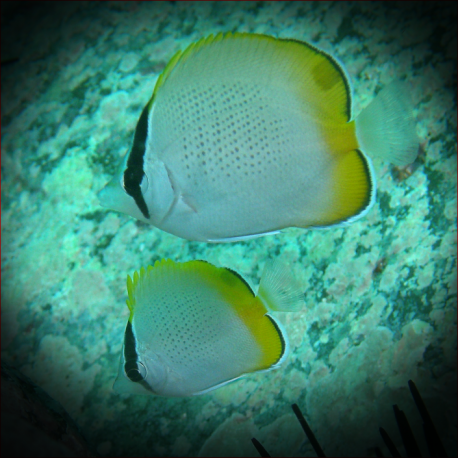More info
Datasheet
| Minimum Tank Size | 400 litres / 105.67 US gallons |
| Maximum Size | 18.0cm / 7.09inches |
| Reef Compatible | Not reef safe |
| Temperament | Docile |
| Temperature | 22.2°C / 71.96°F - 25.6°C / 78.08°F |
| Specific Gravity | 1.020-1.025 |
| Carbonate Hardness | 8-12 |
| pH | 8.1-8.4 |
General Description
The Crochet Butterflyfish is part of the Chaetodon genus, which consists of species that are similar but can vary greatly in their needs, requiring careful distinction. With attractive patterns and colors, these fish lack spines seen in Angelfish, belonging to the Chaetodontidae family known for seeking soft corals, LPS corals, anemones, tubeworms, and bristleworms. This species can sometimes nibble on clams, including Tridacna species, and enjoys feeding on tubeworms.
Aquarium Suitability
Considered suitable with care, the Crochet Butterflyfish should be kept in a tank with at least 400 liters of water and provided with ample hiding places among live rocks. It is docile, requiring frequent feeding several times a day, especially upon introduction, and prefers a varied diet including larger crustaceans, other invertebrates, small crustaceans, and zooplankton.
Care and Hardiness
Noted for its hardiness, this species requires a specific diet and plenty of space for swimming. It is important to ensure they are healthy upon purchase, free from parasites or infections, as they can be challenging to acclimatize and feed initially. Multiple Butterflyfish of the same species can coexist in one tank if introduced simultaneously.
Reef Suitability
The Crochet Butterflyfish is considered not reef safe, as it may indulge in nibbling activities that can harm certain reef inhabitants like clams. Therefore, caution should be exercised in reef setups with this species.
Aquarium Setup
For the Crochet Butterflyfish, it is crucial to have a well-established aquarium with good hiding spots and enough swimming space. Mimicking their natural behavior by placing food in coral skeletons or stones can help with feeding. Providing a mix of live mussels, zooplankton, or crushed shell foods can entice them to eat.
Behaviour
Known for their docile temperament, these fish generally ignore other tank mates and are peaceful. Howbeit, caution must be taken when housing similar species together, except if they are a mated pair. They exhibit shy behavior and need a peaceful environment to thrive.
Feeding and Diet
The Crochet Butterflyfish should be fed a varied diet consisting of live SPS or LPS corals, larger crustaceans, small crustaceans, zooplankton, and other invertebrates. Feeding multiple times a day, especially initially, is crucial for their health and acclimatization.
Dimorphism
There is no information provided regarding dimorphism for the Crochet Butterflyfish or its captive reproduction.
Habitat and Distribution
This species is found in the Western Pacific, spanning from southern Japan to Taiwan, Papua New Guinea to the Great Barrier Reef, and reaching Lord Howe Island and New South Wales. Occasionally, it can also be spotted in locations like Tonga.

